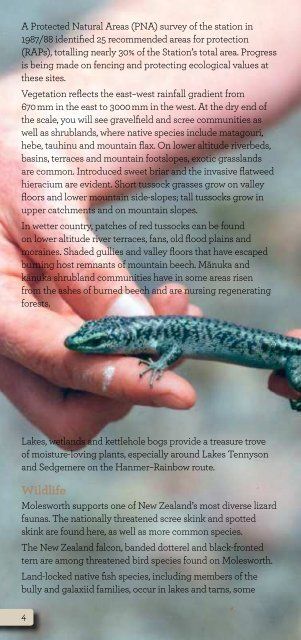Molesworth Station, South Marlborough - Department of Conservation
Molesworth Station, South Marlborough - Department of Conservation
Molesworth Station, South Marlborough - Department of Conservation
Create successful ePaper yourself
Turn your PDF publications into a flip-book with our unique Google optimized e-Paper software.
A Protected Natural Areas (PNA) survey <strong>of</strong> the station in<br />
1987/88 identified 25 recommended areas for protection<br />
(RAPs), totalling nearly 30% <strong>of</strong> the <strong>Station</strong>’s total area. Progress<br />
is being made on fencing and protecting ecological values at<br />
these sites.<br />
Vegetation reflects the east–west rainfall gradient from<br />
670 mm in the east to 3000 mm in the west. At the dry end <strong>of</strong><br />
the scale, you will see gravelfield and scree communities as<br />
well as shrublands, where native species include matagouri,<br />
hebe, tauhinu and mountain flax. On lower altitude riverbeds,<br />
basins, terraces and mountain footslopes, exotic grasslands<br />
are common. Introduced sweet briar and the invasive flatweed<br />
hieracium are evident. Short tussock grasses grow on valley<br />
floors and lower mountain side‑slopes; tall tussocks grow in<br />
upper catchments and on mountain slopes.<br />
In wetter country, patches <strong>of</strong> red tussocks can be found<br />
on lower altitude river terraces, fans, old flood plains and<br />
moraines. Shaded gullies and valley floors that have escaped<br />
burning host remnants <strong>of</strong> mountain beech. Mānuka and<br />
kānuka shrubland communities have in some areas risen<br />
from the ashes <strong>of</strong> burned beech and are nursing regenerating<br />
forests.<br />
Lakes, wetlands and kettlehole bogs provide a treasure trove<br />
<strong>of</strong> moisture‑loving plants, especially around Lakes Tennyson<br />
and Sedgemere on the Hanmer–Rainbow route.<br />
Wildlife<br />
<strong>Molesworth</strong> supports one <strong>of</strong> New Zealand’s most diverse lizard<br />
faunas. The nationally threatened scree skink and spotted<br />
skink are found here, as well as more common species.<br />
The New Zealand falcon, banded dotterel and black‑fronted<br />
tern are among threatened bird species found on <strong>Molesworth</strong>.<br />
Land‑locked native fish species, including members <strong>of</strong> the<br />
bully and galaxiid families, occur in lakes and tarns, some<br />
4<br />
Penwiper— Notothlaspi rosulatum. Photo: Cathy Jones<br />
Scree skink. Photo: Garry Holz<br />
unique to <strong>Marlborough</strong>. Rivers and streams are populated by<br />
native fish species and trout.<br />
There is still much to learn about New Zealand native insects,<br />
but several species <strong>of</strong> spectacularly large giant wētā occur<br />
within <strong>Molesworth</strong>, as do speargrass weevils.<br />
5

















